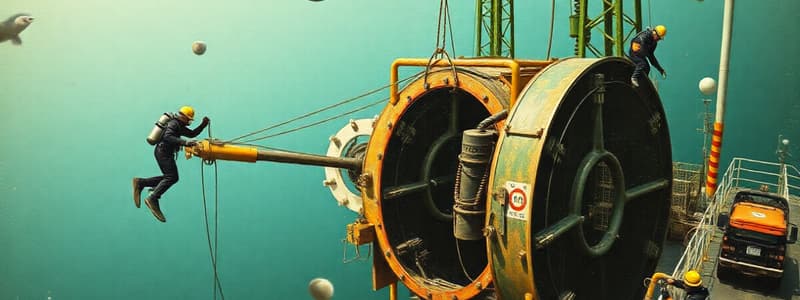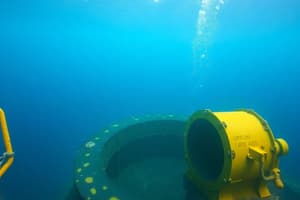Podcast
Questions and Answers
During the subsea spool tie-in operations, what primary factor contributed to the crane hook striking the diver's helmet?
During the subsea spool tie-in operations, what primary factor contributed to the crane hook striking the diver's helmet?
- The diver's failure to follow the correct ascent procedure back to the diving bell.
- Miscommunication and assumptions regarding the position of the crane hook relative to the seabed and the PHF. (correct)
- A sudden and unpredicted shift in the seabed's stability, altering the position of the PHF.
- The unexpected failure of the diver's helmet to withstand the impact, causing disorientation.
What immediate actions demonstrated effective emergency response after the crane hook struck the diver's helmet?
What immediate actions demonstrated effective emergency response after the crane hook struck the diver's helmet?
- Extensive on-site medical evaluation, a detailed incident report, and immediate suspension of all diving operations.
- Complete disassembly of the PHF to assess structural damage, which ensured no further risk to personnel.
- A comprehensive inspection of the crane's cables and hook mechanism before further use.
- The diver's prompt return to the diving bell accompanied by assistance from another diver, ensuring safety. (correct)
Which of the following measures could most effectively address the root causes identified in the incident involving the crane hook and diver's helmet?
Which of the following measures could most effectively address the root causes identified in the incident involving the crane hook and diver's helmet?
- Restricting diving operations to daylight hours only to improve visibility conditions.
- Implementing clear, confirmed communication protocols and utilizing enhanced visibility aids to accurately monitor the position of equipment. (correct)
- Upgrading all diving helmets with enhanced impact resistance and installing additional emergency communication systems.
- Mandatory psychological evaluations for all diving personnel to improve stress response under pressure.
What critical factor related to equipment setup was identified as a direct cause of the incident?
What critical factor related to equipment setup was identified as a direct cause of the incident?
Besides reinforcing communication, what procedural update was implemented by the member to prevent similar incidents?
Besides reinforcing communication, what procedural update was implemented by the member to prevent similar incidents?
Flashcards
What happened during the incident?
What happened during the incident?
The crane hook unexpectedly struck a diver's helmet during subsea spool tie-in operations due to miscommunication and poor visibility.
What caused the incident?
What caused the incident?
Inadequate crane pennant length and poor visibility hindered accurate observation of the crane hook's position.
How to prevent similar incidents?
How to prevent similar incidents?
Ensure adequate distance between divers and the crane hook by using a sufficient pennant length.
Enhance visibility aids and monitoring
Enhance visibility aids and monitoring
Signup and view all the flashcards
Importance of communication
Importance of communication
Signup and view all the flashcards
Study Notes
- During subsea spool tie-in operations, a crane hook struck a diver's helmet unexpectedly.
- The incident occurred during subsea spool tie-in operations in conditions of poor visibility.
- The diver was unharmed, but the helmet was damaged beyond repair, including the side block.
Sequence of events
- After landing the pipe handling frame (PHF) on the seabed, the Diving Supervisor instructed the crane operator to lower the crane hook to allow the diver to disconnect rigging.
- The crane operator reported "no weight" on the crane wire.
- The Diving Supervisor assumed the hook reached the seabed.
- The supervisor instructed the diver to disconnect the PHF from the crane.
- While positioned beneath the PHF, the crane hook struck the diver's helmet.
Positive Outcomes
- Diver 2 assisted Diver 1 promptly to ensure no injuries occurred.
- Both divers returned to the bell safely.
- Divers and the crane block had locating beacons.
- All procedures, lifting plans, and Job Hazard Analysis (JHA's) were followed.
- Protective equipment prevented injury due to impact absorption.
Negative Outcomes
- The crane landed on top beam of the PHF, resulting in a 'no weight' reading.
- This outcome caused the crane operator to assume the hook had reached the seabed.
- The hook slipped off the beam and struck the side of the diver's helmet.
Causes of the incident
- The crane pennant/stinger's length was inadequate and did not provide enough distance between the divers and the crane hook.
- Visibility was poor, hindering accurate observation of the crane hook's position.
Lessons and Actions
- Ensure adequate distance between divers and crane hook: The crane pennant/stinger should be long enough for safe distance.
- Improves safety in particularly limited visibility conditions.
- Improve visibility aids and monitoring: Use alternate methods in conditions of poor visibility.
- Alternative methods could include extra locating beacons, underwater cameras or sonar to improve tracking
- This can help prevent misjudgments regarding the location of the crane hook.
- Reinforce communications, challenge assumptions: Assumptions regarding equipment position should be minimised.
- Should reinforce clear communication and confirmation procedures to ensure all parties are fully aware of the equipment's location at all times.
- Update project procedures to specify minimum pennant lengths for different operations;
- Conduct pre-operation inspections of all rigging and lifting equipment, including crane hooks and pennants, to ensure they meet safety standards and are appropriate for the operation;
- Update the Job Hazard Analysis (JHA) to incorporate lessons learned from this incident, particularly regarding safe distances, visibility, and communication requirements for subsea lifting operations.
Studying That Suits You
Use AI to generate personalized quizzes and flashcards to suit your learning preferences.




